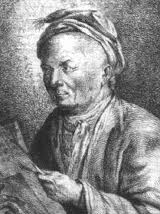 Gottfried August Homilius is not a name that rings any bells outside of Germany. But judging from the world premiere recording of the German composer’s setting of the Biblical Passion according to St Matthew, we should be paying a bit more attention to this low-profile composer.
Gottfried August Homilius is not a name that rings any bells outside of Germany. But judging from the world premiere recording of the German composer’s setting of the Biblical Passion according to St Matthew, we should be paying a bit more attention to this low-profile composer.
- Classical Music 101: What Does A Conductor Do? - June 17, 2019
- Classical Music 101 | What Does Period Instrument Mean? - May 6, 2019
- CLASSICAL MUSIC 101 | What Does It Mean To Be In Tune? - April 23, 2019
 The German music publisher Carus has issued this 2-hour-and-10-minute work in 2-CD box on its in-house label. The elegant performances come from a quartet of German soloists, the 20-member Basel Madrigalisten and the L’arpa festante 27-member period-instrument orchestra led by Fritz Näf.
The German music publisher Carus has issued this 2-hour-and-10-minute work in 2-CD box on its in-house label. The elegant performances come from a quartet of German soloists, the 20-member Basel Madrigalisten and the L’arpa festante 27-member period-instrument orchestra led by Fritz Näf.
This particular setting of the St Matthew Passion doesn’t have a date attached to it, but it was written after Homilius (1714-1785) became a church music director in Dresden in 1755 and before Carl Philipp Emanuel Bach moved to Hamburg to take on a church music directorship in 1768.
Bach loved this music so much that he quoted it repeatedly in subsequent years. Bach’s appreciation may also have helped save the piece from annihilation, because little of Homilius’s work survived the firebombing of Dresden during World War II.
So what we have is a sort of Baroque-Classical hybrid, which makes it a fascinating listen as it clearly bridges the contrapuntal style of Homilius’s famous teacher, J.S. Bach, with the more flexibly expressive, melody-focused style of the late 18th century.
The form of the Passion is old-fashioned in itself. By this point in Germany, the large-scale choral presentations of the Passion stories had moved to poetically inspired re-tellings rather than settings of the exact Biblical text. But Homilius chose to go back to basics.
We get a detailed retelling in a succession of recitative, aria and arioso, choruses and good-old Lutheran chorales.
Homilius was a follower of a new school of musical expression that experimented with changing moods within one piece of music, something that culminated in the sturm und drang of the late 18th century. But this is early stuff, so it’s more aristocratic than fiery. There is a lot of gorgeous writing for woodwinds as well as voices.
The whole is presented very nicely and is well worth trying to track down. The booklet notes provide good background information and the full text.
You can find details (in German) as well as audio samples here.
To get an idea of what Homilius’s work sounds like, here is the choir of his first church in Dresden, the Kreuzkirche, in the first 10 minutes from world premiere recording of the St John Passion a few years ago. It is followed by a little chorale prelude played by Winfried Enz on the organ of Saint-Pierre-le-Jeune Protestant Church in Strasbourg, France:
John Terauds
- Classical Music 101: What Does A Conductor Do? - June 17, 2019
- Classical Music 101 | What Does Period Instrument Mean? - May 6, 2019
- CLASSICAL MUSIC 101 | What Does It Mean To Be In Tune? - April 23, 2019



